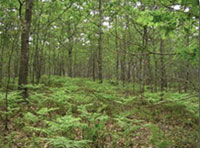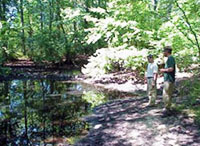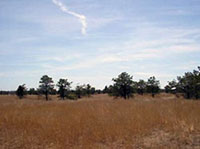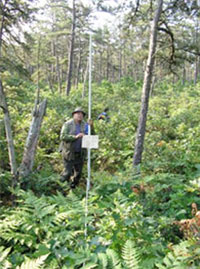Natural Habitat
 Camp Edwards has a variety of natural communities, some unique to Cape Cod. In general the natural communities of Camp Edwards are often referred to as Pine Barrens. Camp Edwards has one of the few remaining stands of Pine Barrens in the Nation. It is the largest Pine Barrens system north of New Jersey.
Camp Edwards has a variety of natural communities, some unique to Cape Cod. In general the natural communities of Camp Edwards are often referred to as Pine Barrens. Camp Edwards has one of the few remaining stands of Pine Barrens in the Nation. It is the largest Pine Barrens system north of New Jersey.
Pitch pine/scrub oak barrens occur on deep, coarse, well-drained sands derived from glacial outwash, in the coastal plain, the Connecticut River Valley, and other scattered areas throughout the northeast. The sands are acidic, nutrient poor and drought prone. The low vegetation and sandy soils contribute to a tendency to be hotter than more mesic sites on summer days, with greater cooling at night, so have great temperature variations daily. The dry environment with low humidity contributes to the loss of heat at night, as in a desert. Exposure to the temperature variations may make plants more susceptible to other damaging factors such as insects or disease. In pitted outwash plains or rolling moraines, some low bowls, or kettles, are frost pockets and have more heath and lichen and less oak and pine. Deeper kettles may intersect the water table and have a Coastal Plain Pond at the bottom.
 Pitch pine/scrub oak barrens are a fire maintained and fire dependent type of natural community: some of the component species depend on recurrent fires for their existence, and many of the species have volatile oils that actually encourage the spread of fires once they are ignited.
Pitch pine/scrub oak barrens are a fire maintained and fire dependent type of natural community: some of the component species depend on recurrent fires for their existence, and many of the species have volatile oils that actually encourage the spread of fires once they are ignited.
Development on Camp Edwards has historically included barracks, parade grounds, runways, and other facilities. As military activity at Camp Edwards decreased and facilities were abandoned and removed, this newly opened space has become forests and fields. At the same time, areas surrounding the base are developing at an alarming rate. As a result, Camp Edwards now represents an island of undeveloped land surrounded by a sea of development on Cape Cod.
An initial floristic survey of the JBCC identified 433 species of vascular plants (Jenkins 1994). Annual plant and rare plant surveys have identified an additional 124 specimens since 1994, increasing the total number of known plant species on Camp Edwards to 557. Data from the plant surveys originally indicated seven major plant communities on Camp Edwards. These communities were classified according to The Nature Conservancy Albany Pine Bush Reserve Classification System: mixed woods forest, pitch pine-scrub oak forest, hardwood forest, scrub oak barrens, grasslands, wetlands, and disturbed communities. The natural communities of Camp Edwards and the JBCC in 2004 were reclassified using the Massachusetts Natural Heritage and Endangered Species Program's Natural Communities Classification (Swain and Keasley 2001). Some smaller undescribed plant communities, such as aspen Populus depressions also exist within the predominant natural communities.
 The plant communities of Camp Edwards are generally classified as mid to late successional forest with intermittent early successional disturbed areas and kettle-hole ponds and wetlands. The climax plant community on Camp Edwards is likely an oak-pine forest with gray birch (Betula populifolia), American beech (Fagus grandifolia), and bitternut hickory (Carya cordiformis) (Foster and Motzkin 1999). Many of the plant communities at Camp Edwards have been influenced by several different factors including fire, ice storms, frost, drought, insect outbreaks, hurricanes, tropical storms, and historic logging and grazing. Natural or human induced fires have played an important role in creating and maintaining the plant communities on Camp Edwards.
The plant communities of Camp Edwards are generally classified as mid to late successional forest with intermittent early successional disturbed areas and kettle-hole ponds and wetlands. The climax plant community on Camp Edwards is likely an oak-pine forest with gray birch (Betula populifolia), American beech (Fagus grandifolia), and bitternut hickory (Carya cordiformis) (Foster and Motzkin 1999). Many of the plant communities at Camp Edwards have been influenced by several different factors including fire, ice storms, frost, drought, insect outbreaks, hurricanes, tropical storms, and historic logging and grazing. Natural or human induced fires have played an important role in creating and maintaining the plant communities on Camp Edwards.
The species diversity of the forests of Camp Edwards is generally quite low. On average, 53 species of plants were documented in each plant community of Camp Edwards, which when compared to most fertile woods of western New England that typically have up to 200 plant species, is relatively low (Jenkins 1994).
The following are brief descriptions of the Natural Communities of Camp Edwards as per the Classification of Natural Communities (Swain and Kearsely 2001):
Plantations:
Prior to the creation of the Massachusetts Military Reservation in the 1935, the area north of Wood Road was managed as pine, spruce, and fir plantations as part of Shawme State Forest. Areas were frequently burned over and planted with Austrian pine (Pinus sylverstris), white pine (Pinus strobus), red pine (Pinus resinosa), Spanish pine (Pinus sp), Douglas fir (Pseudotsuga menziesii), balsam fir (Abies balsamea), Norway spruce (Picea abies), and larch (Larix sp) between 1925 and 1934 (U.S. Department of Agriculture 1932).
Pitch Pine-Oak Forest Woodland:
The Pitch pine-oak forest woodland of Camp Edwards varies with
 degree of maturity. The structure of the forest ranges from a low canopy with a dense shrub layer to a taller canopy with a sparser shrub layer. In general, the plant community is in a mid-successional state where trees and shrubs are increasing in number, while forbs and grasses are becoming less abundant. The woodlands in the northern area of Camp Edwards tend to have a higher and denser canopy than the other forest communities. This may be due to less historic disturbance, resulting in a more mature forest.
degree of maturity. The structure of the forest ranges from a low canopy with a dense shrub layer to a taller canopy with a sparser shrub layer. In general, the plant community is in a mid-successional state where trees and shrubs are increasing in number, while forbs and grasses are becoming less abundant. The woodlands in the northern area of Camp Edwards tend to have a higher and denser canopy than the other forest communities. This may be due to less historic disturbance, resulting in a more mature forest.
The pitch pine-oak forest woodland of Camp Edwards has a low canopy of pitch pine (Pinus rigida) and tree oaks; black oak (Quercus velutina), scarlet oak (Q. coccinea), and white oak (Q. alba) and a moderately continuous shrub layer of blueberry (Vaccinium spp.), black huckleberry (Gaylussacia baccata), sheep laurel (Kalmia angustifolia), and scrub oak (Q. ilicifolia). The sparse forbe layer consists of braken fern (Pteridium aquilinum), wintergreen (Gaultheria procumbens), and Pennsylvania sedge (Carex pensylvanica). The low forest canopy, about 10-15m tall, indicates a relatively young forest of no more than 100 years old.
Pitch Pine-Scrub Oak Community
In areas of forest from which hardwood trees were historically cleared, the plant community is almost entirely pitch pine (Pinus rigida) with an understory of sometimes very dense scrub oak (Quercus ilicifolia) (Jenkins 1994). Other tree species that are present but not common to the community are scotch pine (Pinus sylvestris), white oak, and scarlet oak. Scotch pine was likely introduced to Camp Edwards in the late 1920's and the early 1930's as plantations in Shawme State Forest (U.S. Department of Agriculture 1932). The prevalent shrub species of Camp Edwards, black huckleberry (Gaylussacia baccata), blueberry (Vaccinium spp.) are commonly interspersed among scrub oak.
The structure of the pitch pine-scrub oak communities varies greatly with age. Younger stands are short, dense thickets of immature pitch pine. Immature pitch pine is relatively low in plant diversity and often occurs along roads, old firebreaks, or other previously disturbed areas, and comprises a total of 1% of Camp Edwards. The primary value of the immature pitch pine is habitat for prairie warblers. As the pitch pine matures, the forest has a more closed canopy, which ultimately out competes scrub oak for sunlight. However, in areas where pitch pine has been cleared, scrub oak often grows in extremely dense patches. In the pitch pine-scrub oak community, trees and shrubs in general are growing at a rate greater than in any other plant community, indicating a somewhat young, but rapidly maturing forest.
The diversity of the pitch pine-scrub oak community, 51 plant species, is about average for the plant communities of Camp Edwards. However, pitch pine and scrub oak are the dominant and most productive species in the community.
Black Oak-Scarlet Oak Forest/Woodland
Although pitch pine is the dominant tree species on Camp Edwards, some small stands of hardwood trees exist in the northeastern corner of the training area. Although the community comprises approximately 2% of Camp Edwards, it represents the most advanced state of succession of all of the plant communities. Oaks dominate the tree canopy of these stands and the shrub layer is similar to the pitch pine-mixed oak forest. The structure of the community varies with age from stands of immature hardwoods to more mature forest with a closed canopy and sparse understory.
Scrub Oak Shrubland
Much of Upper Cape Cod has been dominated by pitch pine and scrub oak barrens since the period of colonial settlement (Ruffner and Patterson 2000a). Thomas Bourne stated in 1769 that a large barren wilderness of small pitch pines and scrub oaks make up the space between the settlements [of Sandwich] and indeed the center and for the greater part of the township (Lovell 1984). The area was maintained in an early successional state as a result of timber harvesting and a catastrophic fire that occurred in 1772 (Sawyer 1988). Fire and frost effects typically suppress the growth of pitch pine and other tree species while promoting the growth of scrub oak. Fire scarring causes scrub oak acorns to germinate more readily and terminal buds to die, resulting in the growth of lateral branches. While frequent late spring frosts result in chronic dieback of developing leaves, slow growth rates, and reduced stem height which promotes shrub growth. Eventually, large herds of sheep were grazed throughout the Upper Cape, which limited tree growth and promoted the establishment of the scrub oak barren habitats.